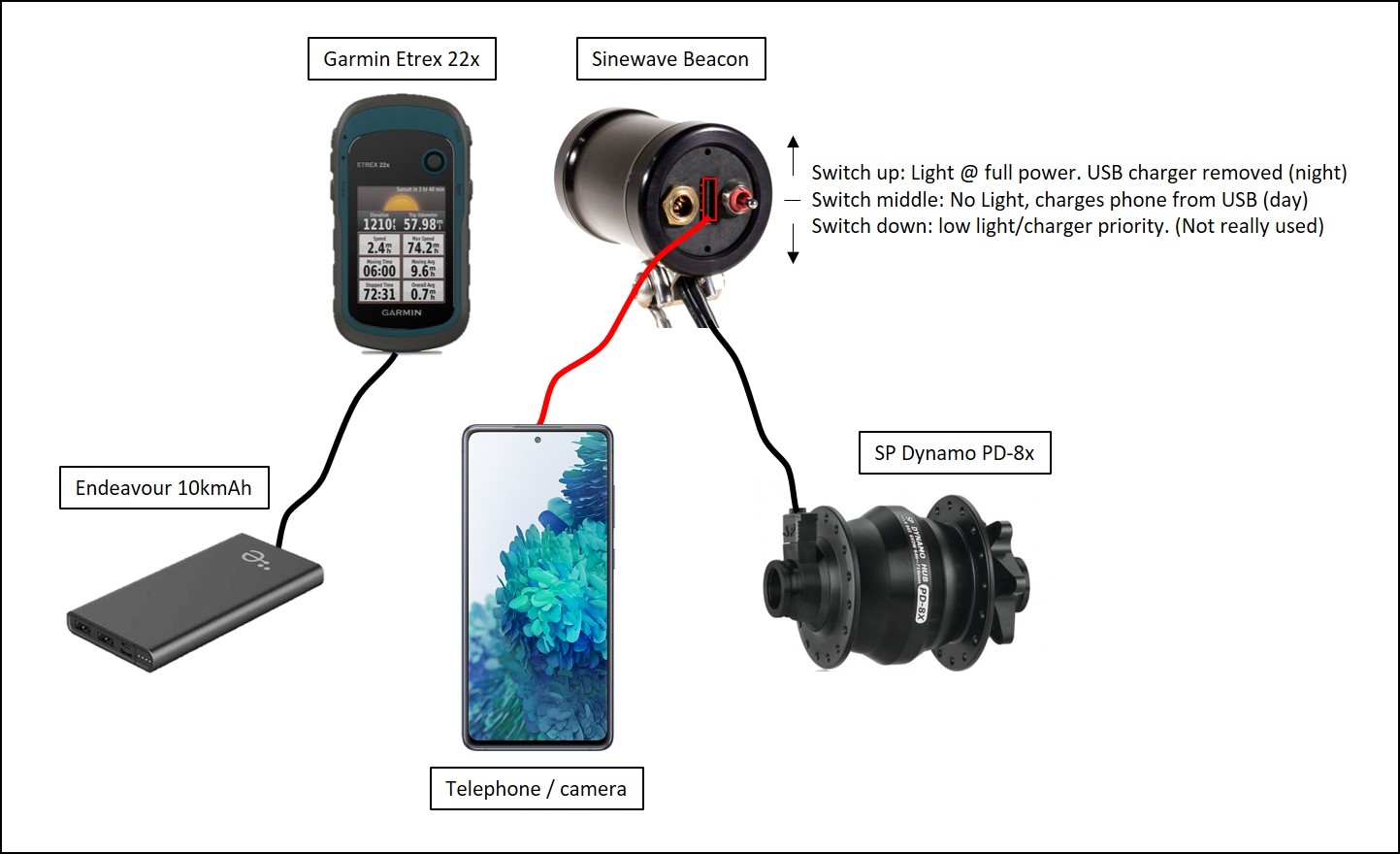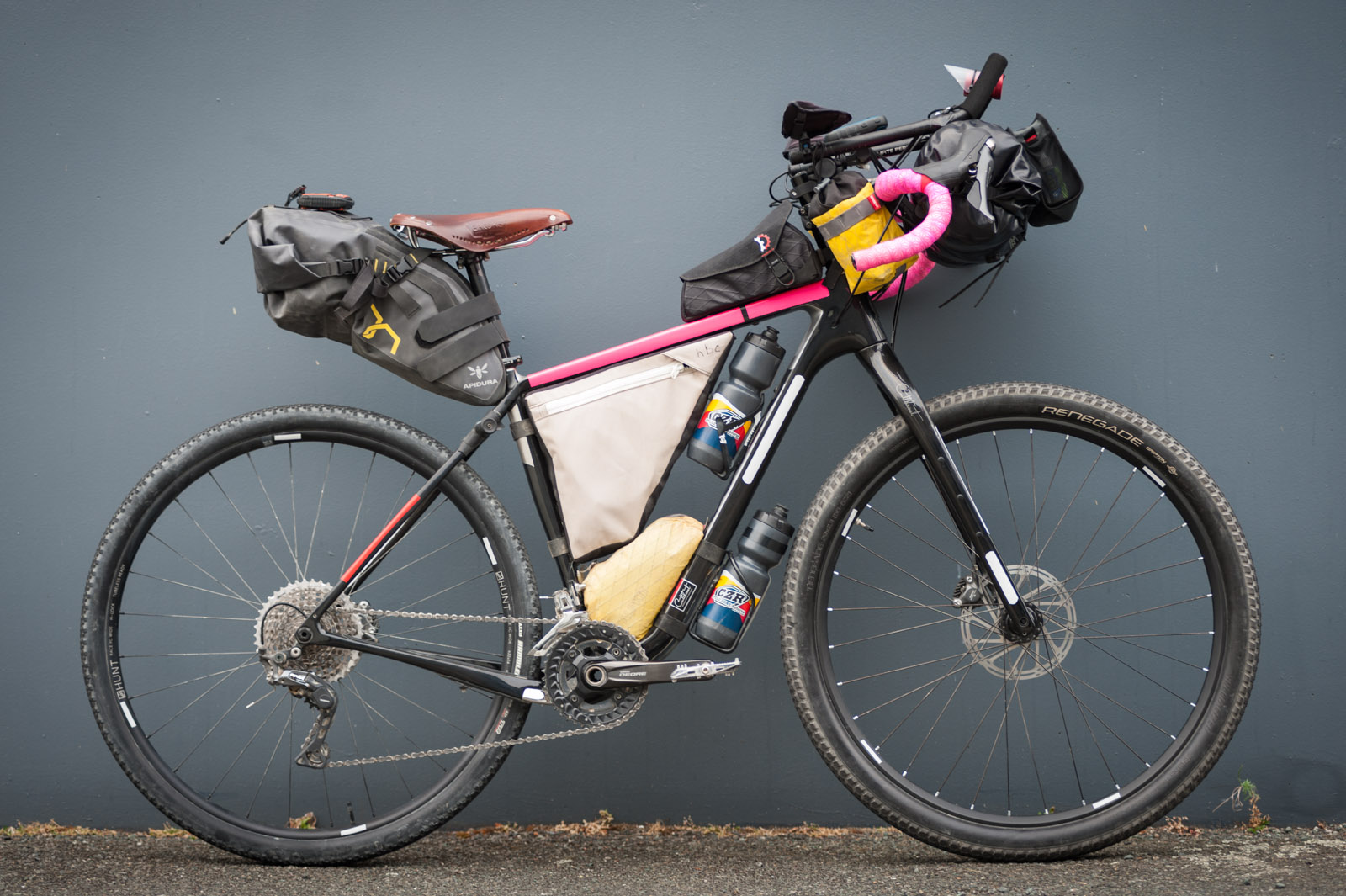The Tuatara 1000 is a bikepacking event in Southland, New Zealand. The inaugural edition took place in February 2021 and covers over 1000km’s of Southland, starting and finishing in Invercargill.
This is my bikepacking setup and gear list.
Bike Setup
The Tuatara 1000 route in 2021 was almost entirely gravel and road. There were a couple of singletrack sections, including one bone-shaking descent off the Otago peninsular, but a gravel bike was the right choice for this event.
I rode my Salsa Cutthroat v2 in comfort/endurance mode – still very similar to my day-to-day gravel setup.
I added Profile Aerobars – the older design for maximum adjustment, with T4+ extensions. These were mounted to a borrowed Fred bar, primarily to get them wide enough.
Wheels: SP PD8x Dynamo hub & DT Swiss XR391 front wheel, and Hunt XC Wide rear wheel. Tyres were my standard setup – Specialized renegade 2.3 on the front, Maxxis rambler 45c on the rear. Plenty of people rode regular gravel bike setups with tyres in the 40-50c range.
Gearing: standard 30-40T Deore double, XX1 10-42 11spd cassette, GRX shifters and derailleurs.
Brooks B17 saddle – heavy AF but comfortable – only got 1 bum-blister that didn’t bother me much once covered with an XL plaster.
Bags
I got some new bags prior to the Tuatara and had plenty of storage space. Despite trying not to take anything unnecessary, I ended up with lots of just-in-case stuff ; food, clothes etc. that I didn’t use. That was partly due to the good weather and how the event played out for me..I packed for a casual tour but then switched to non-stop race mode half way through.
DIY half frame bag: buffs, gilet, rainjacket, Sistema shaker, snack overflow
Small frame bag (repurposed top-tube bag): tube & repair kit
Apidura expedition 17L seatbag: Spare Clothes, washkit. Almost too big for the amount of stuff I had in it. One benefit is the larger sizes keep bulk closer to the seatpost so swaying is minimised.
Salsa EXP Top-load handlebar bag: Sleep system all pre-assembled into a roll. I rotated the bag so the ‘top-load’ was facing forward. I didn’t use the EXP cradle. The bag was attached to a basic handlebar accessory mount (about $7) and cinched down over the aerobar with voile-esque Grunt straps from Bunnings – rock solid setup, did not move at all.
Salsa EXP accessory pouch: snacks etc. The size of the opening is quite annoying for getting things in and out when full. Solidly constructed but think a roll-top version is the way to go – e.g. Revelate Egress, or make your own out of an old cagoule.
Alpkit feedbag 1: phone, powerbank, chargers and cables, spare batteries
Alpkit feedbag 2: potions – suncream, alcohol gel, Tui bug balm, elete electrolytes etc.
Revelate mag tank 2000: More snacks. Borrowed to test it out – large opening is pretty handy for access to cookies on the move.
Bumbag: A last minute addition – useful for takeaway food – pizza and wedges etc.
Sleep system
I like sleeping and am used to 8-9 hours of good quality sleep each night. I’ve been experimenting with Bivy-bagging for a while and now prefer it to small UL tents. I’d been using an Alpkit hunka but wanted something with a little more room, plus the option of bugnet and rain cover, so got myself an OR Helium Bivy.
I also upgraded my mat to a Thermarest NeoAir Xlite. I’d been using a Sea-to-Summit Ultralight insulated mat but eventually accepted that I needed something thicker as a side-sleeper.
The other new item was a luxury pillow – a massive Sierra designs Gunnison. My ultimate weightweenie sleep kit would be this pillow and an XL bin bag. And earplugs – game-changing!
Lighting and Electricity
My rear light was a Bontrager Flare R and I had a small blackburn 100-lumen for my helmet as bonus illumination.
The main light/charging device was a Sinewave Beacon, powered by an SP PD-8X dynamo hub. I carried a basic 10,000mAh powerbank from Noel Leeming – nothing fancy, no pass-through charging etc. This powered my Garmin Etrex 22x and I carried some some spare Lithium AA batteries.
How I used it
Daylight ops: The USB output from the Sinewave beacon was plugged into my phone to keep it topped up with battery.
The Powerbank ran my Garmin Etrex 22x. I topped up the powerbank a couple of times from a wall socket. I’d estimate a 10,000mAh powerbank would keep the garmin running for ~42 hours-ish.
Night ops: Sinewave beacon was the main light. Even at low speeds (there was some very slow grovelling and pushing up hills at night) there was enough light to see far enough ahead. I could have topped up the sinewave output with the powerbank but had a small blackburn 100-lumen light on my helmet instead. I rode through the night twice and never felt short of light.
Below is a wiring diagram:

Navigation
I splashed out on a new Garmin Etrex 22x for the Tuatara 1000. I loaded Klite Kerry’s profile here and did one test ride before the Tuatara – all good!
I didn’t need the features of the high end models. GPS accuracy is good and saved me from mistakenly heading down the wrong ridge in a forest at 3am.
Nutrition
I opted not to take any cooking gear. Food supplies were never more than 100km apart.
Water supply proved to be a much bigger issue, exacerbated by the heat and hills. I took 2x 750ml bottles but should have added a third at least. Carrying a small bladder like the Platypus softbottle would probably be a good idea to expand water capacity. I’ve used Elete electrolytes for years and add this to most water refills.
I used a Sistema ‘Shaker to go’ for cold soaking (spiral bit removed). I carried cous-cous, oxo cubes for flavour, and then added my trail mix of salted peanuts and raisins. Could be prepped with cold water, although hot still better.
Riding food
As the event started in Invercargill, stocking up at Kaye’s bakery seconds shop was an essential nutrition strategy although I went a little overboard – always a sucker for a bargain! I still had cookies left at the finish-line, 4.5 days later
I started off eating John West rice and fish pouches but these made me want to vomit after a couple of days. Standard bar selection: Snak Logs, OSM or bumper bars. Salted peanuts and raisins. Chugging a 750ml bottle of Puhoi Valley Caramel and White chocolate milk was a frequent occurrence – provides over 1000 calories!
There are plenty of cafe’s and shops along the route. The Coach and Horses Inn in Lawrence was one of the highlights – great pizza, coke, wedges. I stuffed my face here and took enough leftovers to last me the next 7 hours.
Weight-weenie gear list
I’d probably ditch several items for next time, either because I didn’t use them or now know they’re unnecessary. Because of good weather I didn’t use rainpants or the puffer jacket but would probably still take both.
| Item | Component | Mass (grams) |
|---|---|---|
| Sleeping Bag | Big Agnes Thunderhead SL | 794g |
| Mat | Thermarest NeoAir Xlite (R) | 340g |
| Bivy | OR Helium bivy – with pole | 476g |
| Pillow | Sierra Designs Gunnison | 102g |
| Item | Component | Mass (grams) |
|---|---|---|
| Long spoon | Sea to Summit alpha-light | 12 |
| Bowl | Orikaso folding | 42 |
| Pot | Sistema Shaker to Go | 127 |
| Item | Component | Mass (grams) |
|---|---|---|
| Camp trousers | Izas outdoor | 290 |
| L/S Tee | Kathmandhu Merino | 185 |
| Puffer jacket | Macpac | 350 |
| Long boxers | Icebreaker x 2 | 170 |
| Riding Socks | 1x spare pair | 45 |
| Camp socks | Bridgedale | 55 |
| Item | Component | Mass (grams) |
|---|---|---|
| Jacket | OR Helium 2 | 180 |
| Trousers | Macpac pertex | 141 |
| Gloves | Pink Ansell washing up gloves – size L | 20 |
| Item | Component | Mass (grams) |
|---|---|---|
| Towel / flannel | Sea to Summit Airlite M | 28 |
| Toothpaste & brush | Air New Zealand travel kit | 22 |
| Other stuff | showergel, ibuprofen etc | 72 |
| Item | Component | Mass (grams) |
|---|---|---|
| Tap Key | Mitre 10 – an NZ bikepacking essential | 35 |
| Power bank | Noel Leeming Endeavour 10000mAh | 236 |
| GPS | Garmin Etrex 22x | 142 |
| Shopping bag | Sea to Summit paclite rucksack | 30 |
| Lights | Bontrager Flare R / Blackburn Central | 98 |
| Tracking | Spot Gen 3 | 122 |
Repair Kit – 190g
Electrical tape, Tyres slugs, Zip ties, Quicklink pliers, Valve core, Presta/Schrader adaptor, Tyre patches/boot, valve core remover, derailleur hangar.
Plus: small bottle of sealant, Squirt lube and rag, Pump, 29″ tube, Topeak multitool
What would I change next time?
The TL;DR is: take less stuff! Part of the issue was my indecision about ‘touring’ or ‘racing’ the route. If I did the Tuatara again, I’d probably commit to race-mode meaning less spare clothes and a different sleep plan – probably very minimal bivy bag and pillow setup for a few hours here and there. There’s plenty of accommodation around if required. Even if committing to #partypace, I’d possibly opt for hostels and motels instead of sleeping in the bushes.
The biggest error was lack of water-carrying capacity. There are several long sections of gravel hills with no re-supply. I could have used an extra 1-1.5 litres probably (above the 1.5L I carried), although it was particularly hot in 2021 – unsure if that’s normal for Southland!

